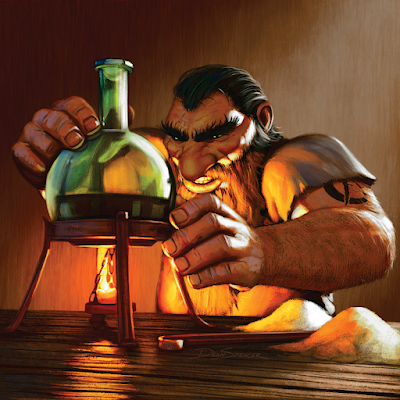While partaking of the excellent Eldritch Lorecast last week, I listened to the team talk with increasing degrees of lament about the chronic lack of a solid magic item crafting system in D&D. Different approaches from different games and game systems were discussed at some length, along with the different goals that characters and players often have for magic item crafting. (For those interested, that discussion is here.)
In the end, the consensus was that there are simply too many different approaches the game can take to magic item crafting, and all those approaches typically fall flat at some point. It was then left to the uber-talented James Haeck (who I’ve been fortunate enough to have worked alongside on numerous projects) to comment that there’s likely no way to ever make everyone happy with a magic item crafting system unless there’s a genius game designer out there who can thread that needle.
And, well, here I am. 😀
Chapter 8 (Player's Guide) and Chapter 2 (Magic Grimoire) Excerpts — Magic Item Crafting Preview
CORE20 has a fairly straightforward and extremely usable approach to magic item crafting, because that approach is built on a number of straightforward and usable foundational steps. At the base of the process is the idea that in the game, characters have ways to earn income during downtime that are tied to their skills. The wages that a character can earn week to week during downtime are synced up with the wages earned by NPC hirelings in the game, with most characters’ advanced state of skill use letting them easily pull down expert hireling wages whenever they’re not actively adventuring.
The rules for crafting mundane items are in turn tied to the rules for earning income. The game’s crafting rules are built around the idea that instead of earning a certain number of gp working for someone else, a character can instead create weapons, art objects, armor, alchemical substances, and more at half cost. Effectively, a character crafting an item pays half the item’s typical market cost for raw materials and overhead, then provides their own labor for free.
Building on the rules for mundane item crafting, magic item crafting functions in exactly the same way — albeit at a higher level of artisanship and specialized knowledge. Creating magic items involves the labor of master crafters, magic users, and the item crafter, but when all those artisans come together, they do so using the same rules for crafting mundane items. (The thing that allows crafting magic items to use the same rules of in-game economy as crafting mundane items is the way that magic items fit properly into the overall economy of the CORE20 game world, as talked about in a previous update.)
At its heart, the CORE20 system is a game focused on letting characters and players do whatever they want to do as heroes in a high-magic world. Making it easy for characters to craft magic items as part of downtime, making use of their own skills and of the connections with other characters and NPCs derived from their adventures, is just another part of that.
(Art by Dean Spencer)


